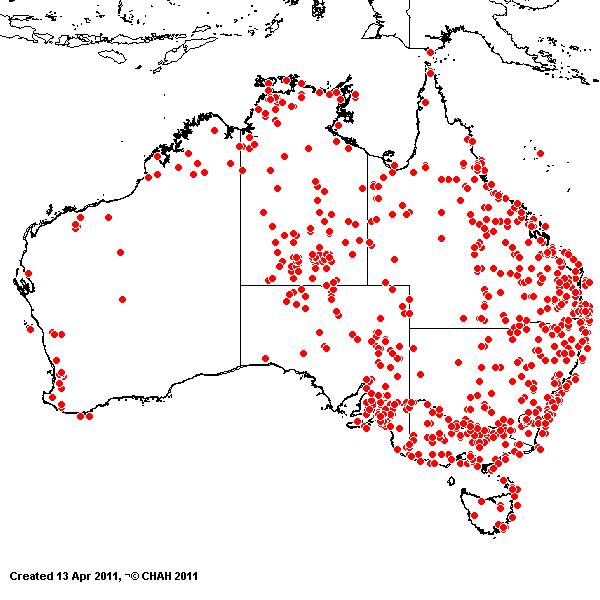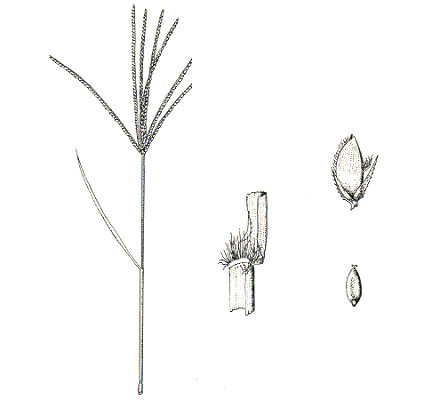Cynodon dactylon* (L.) Pers. Syn.
Pl. 1: 85 (1805).
Classification. (GPWG 2001) : Subfamily
Chloridoideae. Cynodonteae.
Basionym and/or
Replacement Name: Panicum
dactylon L., Sp. Pl.
1: 58 (1753).
Type of Basionym or
Protologue Information: In europa australi,.
Key references
(books and floras): [1810]. R.Brown, Prodromus (187), [1878]
G.Bentham, Flora Australiensis 7 (609), [1952] C.A.Gardner, Flora of
Western Australia 1 Gramineae (216), [1980] M.Lazarides, Tropical
Grasses S.E.Asia (57), [1981] M.Lazarides in J.Jessop (ed)., Flora of
Central Australia (466), [2002] D.Sharp & B.K.Simon, AusGrass,
Grasses of Australia, [2002] J.Wheeler, N.Marchant & M.Lewington, Flora
of the South West (409), [2006] J.Jessop, G.R.M.Dashorst, F.M.James, Grasses
of South Australia (348), [2008] S.W.L.Jacobs, R.D.B.Walley &
D.J.B.Wheeler, Grasses of New South Wales (192).
Illustrations:
[1952] C.A.Gardner, Flora of Western Australia
1 Gramineae (215, Pl. 64), [1983] J.C.Tothill & J.B.Hacker, Grasses
of Southern Queensland (174), [1984]
N.T.Burbidge. rev. S.W.L.Jacobs, Australian Grasses (97), [2005] K.Mallet (ed.), Flora of
Australia 44B: Poaceae 3 (Fig 53A-D as var. dactylon), [2006]
J.Jessop, G.R.M.Dashorst, F.M.James, Grasses of South Australia (349, Fig. 280 as var. dactylon & 350,
Fig. 281 as var. pulchellus), [2008] S.W.L.Jacobs, R.D.B.Whalley &
D.J.B.Wheeler, Grasses of New South Wales, 4th edn (192).
Habit.
Perennial. Rhizomes present, elongated. Stolons present. Culms geniculately
ascending, 8–40 cm tall, 0.5–1 mm diam. Ligule a fringed membrane or a fringe
of hairs, a ciliolate membrane or a ciliate membrane, 0.2–0.3 mm long.
Leaf-blades flat or conduplicate, 1–12 cm long, 0.5–4 mm wide. Leaf-blade
surface scaberulous, glabrous or indumented.
Inflorescence.
Inflorescence digitate, with spicate branches.
Spikelets.
Spikelets sessile. Fertile spikelets 1-flowered, comprising 1 fertile
floret(s), without rachilla extension, ovate, laterally compressed, 1.8–3 mm
long.
Glumes. Glumes
similar, thinner than fertile lemma. Lower glume lanceolate, herbaceous,
keeled, 1-keeled, 1 -nerved. Upper glume lanceolate, herbaceous, keeled,
1-keeled, 1 -nerved.
Florets.
Fertile lemma 1.8–3 mm long, keeled, wingless, 3 -nerved. Palea 2 -nerved.
Continental
Distribution: Europe, Africa, Temperate Asia, Tropical Asia, Australasia,
Pacific, North America, South America, and Antarctica.
Australian
Distribution: Western Australia, Northern Territory, South Australia,
Queensland, New South
Wales, Victoria, Tasmania,
Norfolk I, Lord Howe, Christmas Is, Cocos
Keeling Is, Ashmore Reef, Coral Sea Is.
Western Australia: Gardner, Dampier.
Fortescue, Carnarvon, Austin. Drummond, Warren.
Northern Territory: Darwin & Gulf,
Central Australia North, Central Australia
South. South Australia: North-western, Lake Eyre, Gairdner-Torrens
Basin, Flinders Ranges, Eastern, Eyre Peninsula, Northern Lofty, Murray, Yorke
Peninsula, Southern Lofty, Kangaroo Island, South-eastern. Queensland:
Burke, Burnett, Cook, Darling Downs, Gregory North, Leichhardt, Maranoa,
Mitchell, Moreton, North Kennedy, Port Curtis, South Kennedy, Warrego, Wide Bay,
Gregory South. New South Wales: North Coast, Central Coast, South Coast,
Northern Tablelands, Central Tablelands, Southern Tablelands, North-Western
Slopes, Central-Western Slopes, South-Western Slopes, North-Western Plains,
South-Western Plains, North Far Western Plains, South Far Western Plains. Victoria:
East Gippsland, Eastern Highlands, Gippsland Highlands, Gippsland Plain,
Grampians, Lowan Mallee, Midlands, Murray Mallee, Otway Plain, Otway Range,
Wilsons Promontory, Riverina, Snowfields, Volcanic Plain, Wannon, Wimmera. Tasmania: Furneaux Group, North
West, Midlands, East Coast.
Notes.
There are seven varieties, two occur in Australia, of which the rarer is
endemic.
Cynodon dactylon var. dactylon
Extensively
cultivated as a lawn grass, especially in the tropics, and as a pasture grass
in some areas; becomes dominant after heavy grazing of native pasture on soils
of moderate fertility; a very persistent weed of roadsides, gardens and
pastures.
Cynodon dactylon var. pulchellus
Cynodon dactylon var. pulchellus
appears to be endemic, differing from the cosmopolitan C. var. dactylon
in the hirsute rather than glabrous or sparsely hairy leaves, greyish
colouration, larger lemma with keel cilia three times as long and hairy
sub-margins, and longer rachilla extension. C. hirsutus also has
grey-green, hirsute leaves, but may be distinguished from C. dactylon
var. pulchellus by its frequently three-nerved upper glume, lemma keels
with wings and shorter cilia, and the lack of a rachilla prolongation.
Infra-specific taxa: var. dactylon, var. pulchellus.
Spikes more than 3 cm
long with spikelets to 2.5 mm long C. dactylon var. dactylon
Spikes less than 3 cm long with spikelets 2.5–3 mm
long C. dactylon var. pulchellus







